‘Babylon’: Damien Chazelle Answers Questions About His Costly Early Hollywood Epic
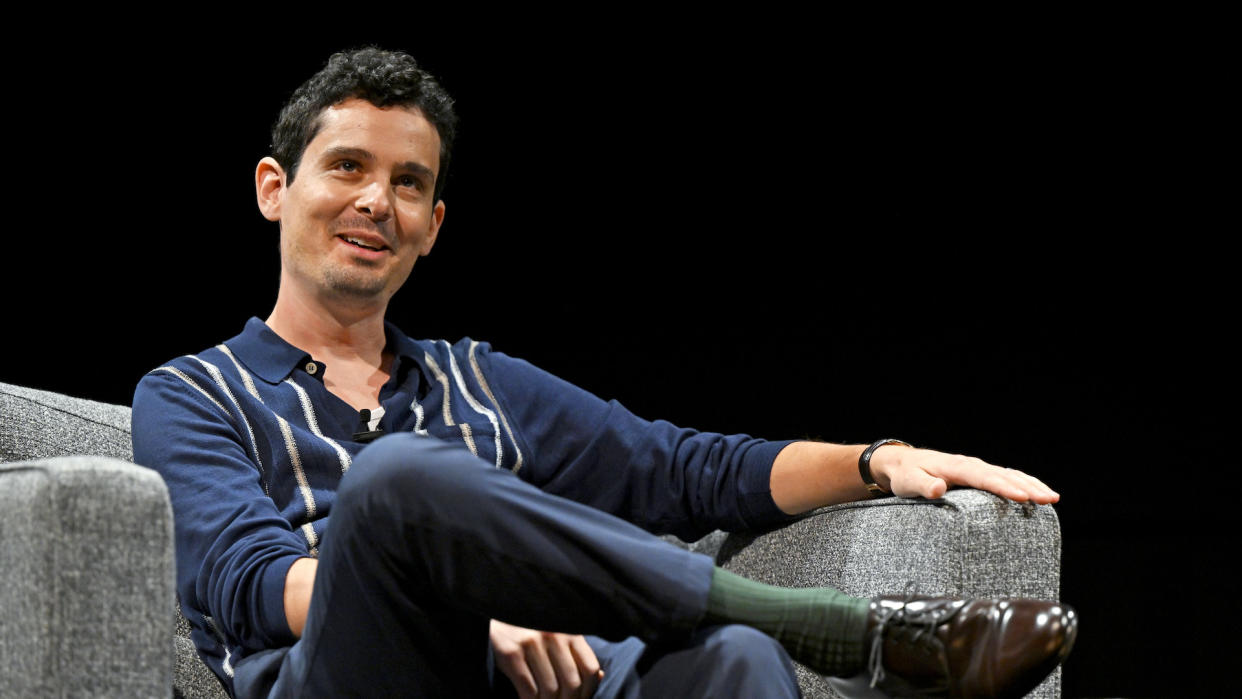
- Oops!Something went wrong.Please try again later.
- Oops!Something went wrong.Please try again later.
What are we to make of “Babylon”? The signs are conflicting. Early word out of preview screenings for what filmmaker Damien Chazelle describes as an “insane early Hollywood vision” was mixed, from “hot mess,” to “sensational celebration of cinema.” (Both are true.) The newly constituted Golden Globes gave the movie five nominations including Best Drama, while the more Oscar predictive Critics Choice Awards went with nine, including Best Picture, Director Chazelle, and Actress Margot Robbie. (When reviews broke Friday, the movie earned a modest 63 Metascore.)
Having invested some $78 million (estimates rise to $100-110 million) in Chazelle’s opus, Paramount Pictures CEO Brian Robbins doubled down on the ambitious three-hour-nine-minute epic ahead of its wide opening on December 23 (changed from the originally-planned limited release), announcing a first-look directing and producing deal with the filmmaker.
More from IndieWire
What are the comps? On the one hand, in 2011 Martin Scorsese’s lavish $180-million period fantasy “Hugo” wound up at $73 million domestic plus five craft Oscars. On the other, in 2013 Baz Luhrmann’s $105-million period extravaganza “The Great Gatsby,” starring Leonardo DiCaprio, scored $150 million domestic and two craft Oscars. Realistically, the studio is looking at the numbers for another, more recent period saga, Ridley Scott’s “House of Gucci,” starring Adam Driver and Lady Gaga, which scored $54 million domestic. (There’s more gold in the international hills as well.)
“We have Brad the movie star,” said Paramount distribution chief Chris Aronson, who says the film will open to an older audience, then pull younger ones, much like Pitt-starrer “Bullet Train” ($103 million domestic). Paramount has another problem: competing for screens with a three-hour-plus juggernaut that is three minutes longer: Jim Cameron’s four-quadrant appeal “Avatar: The Way of Water.” Luckily “Babylon” is chasing only 2D screens. “There is an opportunity for us in this window, we’re the standout film,” said Aronson. “We know there’s an audience for Damien Chazelle and for this film.”
Whatever happens at the box office, the studio plans to squeeze more out of this gifted, self-indulgent filmmaker.
Indeed, it’s easy to throw this exquisitely mounted spectacle into the category of vanity projects directed by filmmakers who were given too much leeway to spend their investors’ money without regard for captivating audiences. The list includes David O. Russell’s starry $80-million comedy “Amsterdam” (worldwide gross: $31.2 million), James Gray’s $15-million family drama “Armageddon Time” ($5.3 million), and Sam Mendes’ 1980s memoir “Empire of Light,” which just opened below expectations.
But there’s a reason that “Babylon” will land a bunch of Oscar nominations, largely in the craft categories, even in a competitive year going up against such splashy Hollywood entertainments as “Top Gun: Maverick” and “Avatar: The Way of Water.”
It’s a gorgeous feat of cinema. Anyone who knows how movies are made can’t help but be impressed.
Here’s how Chazelle went about making “Babylon.”
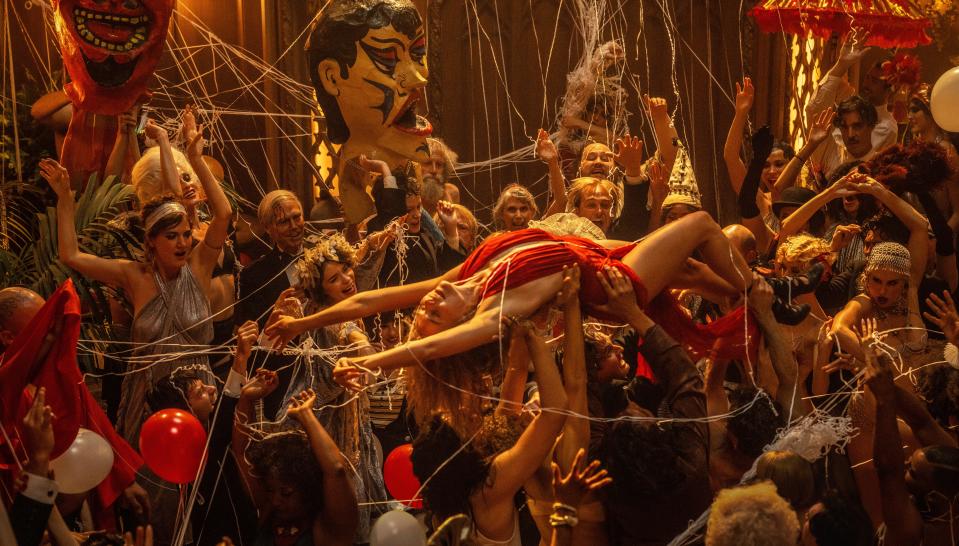
Scott Garfield
He put the cart before the horse.
Chazelle started researching the early Hollywood era when the silents gave way to sound 15 years ago. Between projects he would dive back into his research into the period, from watching documentaries and silent epics like Erich Von Stroheim’s “Greed,” which was cut down from nine hours, and D.W. Griffith’s grandiose “Intolerance” (which features a legendary Babylon sequence) to visiting library archives, which was so much fun that it took years before Chazelle dragged himself away and started the hard work of writing a screenplay.
“It was a little treasure trove I kept dipping into over many years,” he told me over Zoom. “The research was so addictive that it took a conscious decision to finally go, ‘it’s now or never. This should be the movie I should try to make now.’ So I have to close the book, look at these notes I’ve collected over the years, this dense mass of impenetrable stuff, and actually figure out what the roadmap through that would be. I have to take a machete to this and turn this into a story. So stopping one part of the process to begin another actually took a conscious gearshift.”
The filmmaker noticed that towards the end of the 20s, “there was this rash of suicides, deaths, suicidal drug overdoses, a little bit coalescing with a drug epidemic going on at the time,” he said at an Academy Q & A, which coincided with the transition that was covered in “Singing in the Rain,” from the silent to sound eras. “But it gave a brutal face to it. And suddenly looking at the types of behaviors that would lead to those sort of outcomes, that extreme living, passion, ambition, recklessness, and unbridled lust that characterized Hollywood at that time. That started my brain going.”
In other words, he was interested in the milieu. But he still needed to find characters to “guide us through this tumultuous time.” He settled on about six, including rebellious actress Nelly (Margot Robbie), aging silent star Jack (Brad Pitt), wily Mexican elephant wrangler Manny, who rises to a studio executive (Diego Calva), powerful gossip columnist (Jean Smart), a charismatic actress based on Anna May Wong (Li Jun Li), and a trumpeter who becomes a movie star (Jovan Adepo). He never did come up with a strong storyline.
The script was too long.
Even with playing around with the formatting, Chazelle’s script was 180 pages long. “I cheated with the margins,” Chazelle said. “A properly formatted script would have been 220 pages long.” Length was one of the issues that made several studios pass on the project before Paramount came on board.
When Brad Pitt first read the screenplay, he said, “What’s gonna get cut?” Chazelle figured he’d shoot a minute a page. Which is what he did. While Chazelle did trim several sequences, including a marinara food fight and a trip to Mexico, “I was surprised by how much stayed in the movie,” said Pitt, who plays a hard-drinking matinee idol who does not transition easily out of silents.
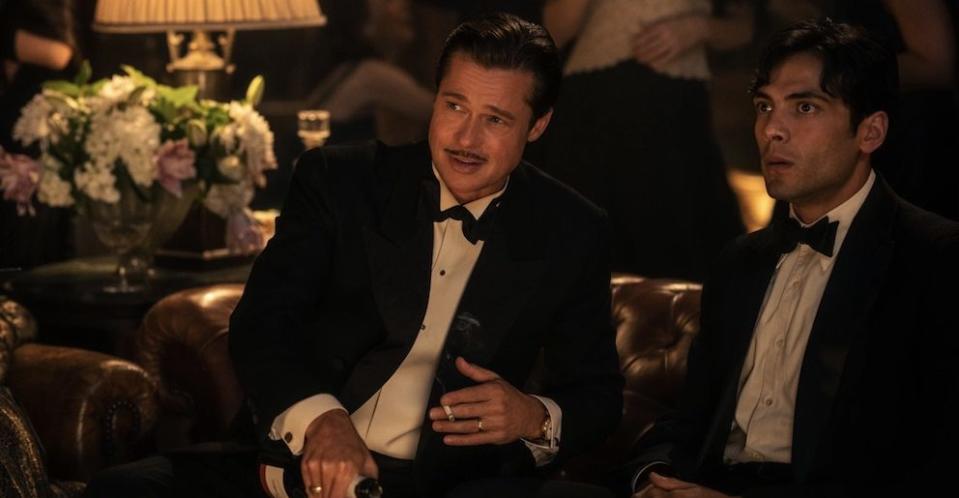
Scott Garfield / Paramount Pictures
The movie wouldn’t have been greenlit if Chazelle had not landed two major movie stars.
“We needed some star power,” said Chazelle. “It came down to Nelly and Jack, the Brad and Margo characters.” At first “La La Land” Oscar-winner Emma Stone was attached, with Pitt mildly interested. One-time Paramount executive Wyck Godfrey and ex-studio chief Jim Gianopulos championed “Babylon.” Paramount signed on for worldwide rights with the idea that Stone would star and a star like Pitt would play Jack. When Covid shut down the project, it almost came to a halt. “The whole movie seemed to fall apart,” said Chazelle. “We got lucky that Brad stuck around and Margot happened to be available. Thank God. We went through several regime changes. We were lucky no one decided to kill us.”
Chazelle directed Margot Robbie to go over the top.
On her first day, Robbie did what she always does. “I go big on the first take,” she said. Chazelle came up to her and said, “‘That was great. I just need way more.’ I was like ‘holy shit, I don’t know if I have more.'”
This helps to explain why Nelly operates at such a frenzied level throughout the film. “A lot of Nelly is inspired by Clara Bow,” said Robbie. “I love [Nelly] so much, but she was so exhausting. She took everything from me.”
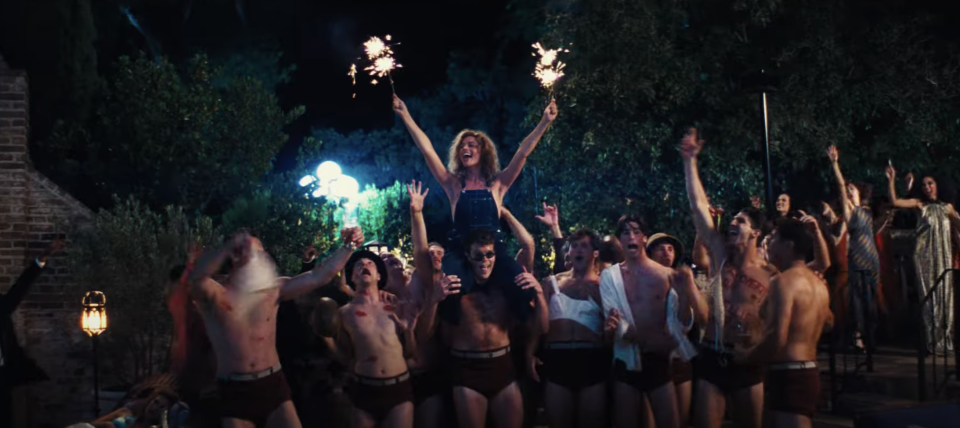
screenshot
Chazelle created tour-de-force cinematic set pieces.
“Babylon” boasts a series of memorable, bravura scenes and moments. Chazelle relied on his “La La Land” team to pull them off, including his Oscar-winning cinematographer Linus Sandgren, Oscar nominated costume designer Mary Zophres, Oscar-winning editor Tom Cross (“Whiplash”), and Oscar-winning composer Justin Hurwitz.
To prepare, everything in the film was storyboarded, and Chazelle shot the big scenes on different locations with his iPhone, and cut them together like an animatic, with music from Hurwitz. Chazelle likes to get the tough stuff out of the way. “Philosophically I am partial to the idea of trying to begin a shoot with something meaty,” he said, “rather than have it loom over your head.”
That’s why Chazelle took the first day of filming to the impossibly hot Simi Valley, to shoot a series of sequences set in the desert on the poverty row studio Kinoscope sets of multiple movies filming at once, including a war battle complete with cannons and a thousand extras. One amazing long shot tracks across all of the different sets. “Believe it or not that’s how we began the shoot, on day one, with that oner,” Chazelle told me. “There might have been moments during that day where I regretted that it was one of the harder day ones I’ve ever had.”
Next came Nelly’s first day shooting a movie, dancing and crying on cue. The next week brought the battlefield scenes. “Those first two weeks were a trial by fire,” said Chazelle. “It’s funny, they were magical. It was so dusty you would come home head to toe covered with dust, and when I take my boots off my feet are caked in dirt and dust. It’s hard to replace when it comes to trying to feel the elements, on a gut level of what some of those silent filmmakers would have felt.”
To mimic that, Chazelle tried to avoid CGI, even when hundreds of his extras would somehow fall away after lunch. They got in the habit of shooting their wide masters at the start of the day. “It became this thing of trying to do everything in camera,” he said. “I just think practical looks better. Especially in those conditions, there’s something about the sun and the sweat and the dirt and shooting in that environment. It made me want to shoot a western. You’re following in the lineage of John Ford getting his start as a stunt rider. It’s in the DNA of Hollywood itself. The animal wranglers and talent is all still out there.”
The extras were important to achieve the depth of field and 35mm anamorphic widescreen spectacle Chazelle had in mind. “I wanted a Cinemascope movie where you feel the frame, you’d feel that each image had been composed in-depth. So you’d have foreground and background. I was so inspired by what Coppola would do in some ‘Apocalypse Now’ sequences where a normal standalone set piece would be in the corner of the frame behind the actors, like some building gets demolished, or a cow gets lifted by a helicopter in the background of the shots.”
The opening party Bacchanalia was also impossibly challenging to film. The ballroom at the Ace Theatre in downtown L.A. required eight days of shooting, with hundreds of extras and an elephant, plus other hallway and room sets filmed in other locations. Exteriors were grabbed at Shea’s Castle in Antelope Valley.
Chazelle and Hurwitz used the music to try and “get at the lifecycle of a party,” the director said. “That’s what all the great party scenes go through — it’s not just this joyful high from the beginning to the end — they’re living organisms that begin in a certain place of innocence, and then maybe they curdle at a certain point, or maybe they go dark or violent. Maybe they restore their sense of optimism at some point. And then the most beautiful part of a party to me is when it ends.”
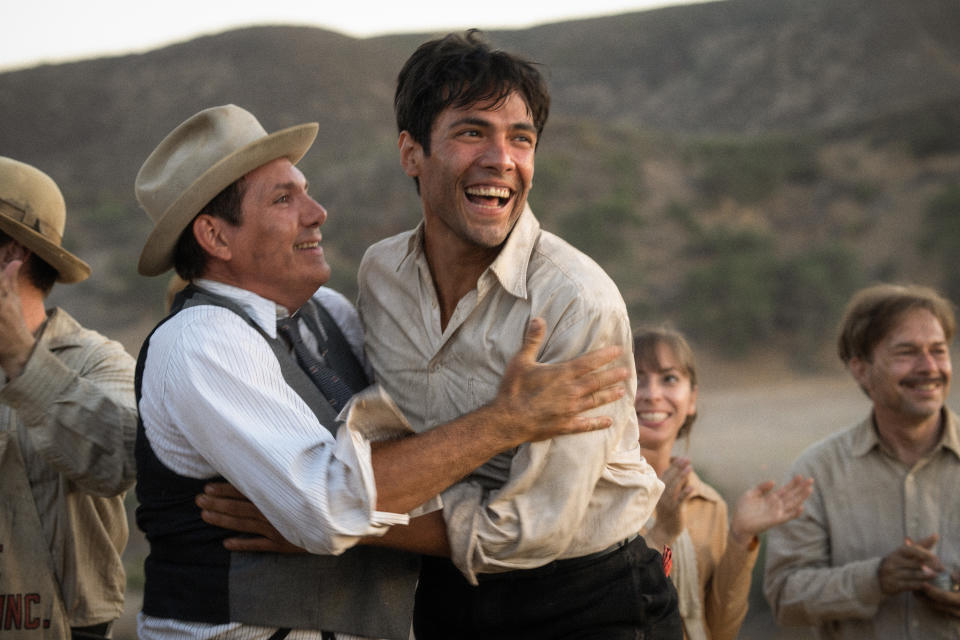
Scott Garfield
One of the film’s most hilarious sequences takes place on a soundstage, as the hapless Nelly tries to learn how to work with a microphone and a very irritated sound mixer, while a cameraman enclosed in a soundproof booth keeps popping out complaining of overheating. “Those camera boxes were death traps,” said Chazelle. “By the time it came to shoot that scene, I had my own horror stories of onset experiences where you feel the wheels are falling off in every direction. And a whole day has passed and you haven’t got a single shot off. It became that much easier to tap into that and try to imagine in a sadistic way the worst day on set for anyone that could be conceived.”
The unexpected ending was created in post.
In editing the movie’s finale with Manny in a movie theater, Chazelle felt somehow underwhelmed. “Given how out there the rest of the movie was,” said Chazelle, “something felt a little too one to one, literal, and safe and snug about the ending.” So he and his editor Tom Cross decided to keep the same ending as scripted, but give him “an epiphany, a moment of clarity, where in some weird way, life makes sense. I needed a loud bang of an ending.”
After he asked the studio for a month to figure it out, that’s what he got.
Paramount will release “Babylon” in theaters on Friday, December 23.
Best of IndieWire
Sign up for Indiewire's Newsletter. For the latest news, follow us on Facebook, Twitter, and Instagram.

